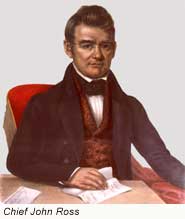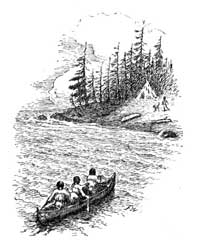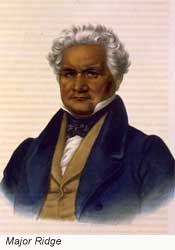The Trail of Tears refers to the forced removal of the Cherokee American Indian tribe by the U.S. federal government, which resulted in the deaths of about 4,000 Cherokee Indians. In the Cherokee language, the event is called Nunna daul Tsuny — "the trail where they cried." The Cherokees were not the only Native Americans forcibly removed to the American West, and so the phrase "Trail of Tears" is sometimes used to refer to similar events endured by other Indian peoples, especially among the "Five Civilized Tribes."

 The rapidly expanding population of the United States early in the nineteenth century created tensions with American Indian tribes located within the borders of the various states. While state governments did not want independent Indian enclaves within state boundaries, Indian tribes did not want to relocate or to give up their distinct identities. With the Compact of 1802, the state of Georgia relinquished to the national government its western land claims (which became the states of Alabama and Mississippi). In exchange, Georgia expected that the national government would work to remove the Indian tribes within Georgia, thus giving Georgia control of all land within its borders. The rapidly expanding population of the United States early in the nineteenth century created tensions with American Indian tribes located within the borders of the various states. While state governments did not want independent Indian enclaves within state boundaries, Indian tribes did not want to relocate or to give up their distinct identities. With the Compact of 1802, the state of Georgia relinquished to the national government its western land claims (which became the states of Alabama and Mississippi). In exchange, Georgia expected that the national government would work to remove the Indian tribes within Georgia, thus giving Georgia control of all land within its borders.
However, the Cherokees, whose ancestral tribal lands overlapped the boundaries of Georgia, Tennessee, North Carolina, and Alabama, declined to move. They established a capital in 1825 at New Echota (near present-day Calhoun, Georgia). Furthermore, led by principal Chief John Ross and Major Ridge, the speaker of the Cherokee National Council, the Cherokees adopted a written constitution on 26 July 1827, declaring the Cherokee Nation to be a sovereign and independent nation. These tensions between Georgia and the Cherokee Nation were brought to a crisis by the discovery of gold near Dahlonega, Georgia in 1829, resulting in the first gold rush in U.S. history. Hopeful gold speculators began trespassing on Cherokee lands, and pressure began to mount on the Georgia government to fulfill the promises of the Compact of 1802.
When Georgia moved to extend state laws over Cherokee tribal lands in 1830, the matter went to the U.S. Supreme Court. In Cherokee Nation v. Georgia (1831), the Marshall court ruled that the Cherokees were not a sovereign and independent nation, and therefore refused to hear the case. However, in Worcester v. State of Georgia (1832), the Court ruled that Georgia could not impose laws in Cherokee territory, since only the national government – not state governments — had authority in Indian affairs.

 As the 23 May 1838 deadline for voluntary removal approached. The current General John Wool was ordered to move the Cherokee, but he refused and resigned from his command in protest. President Van Buren replaced him with General Winfield Scott to head the forcible removal operation. He arrived at New Echota in May 17, 1838, in command of 7,000 soldiers. Soldiers began rounding up Cherokees in Georgia on 26 May 1838; ten days later operations began in Tennessee, North Carolina, and Alabama. About 17,000 Cherokees — along with their approximately 2,000 black slaves — were removed at gunpoint from their homes over three weeks and gathered together in camps, often with only the clothes on their backs. They were then transferred to departure points at Ross's Landing (Chattanooga, Tennessee) and Gunter's Landing (Guntersville, Alabama) on the Tennessee River, and at the Cherokee Agency on the Hiwassee River (Calhoun, Tennessee). From there, they were sent to the Indian Territory, mostly travelling on foot, or by some combination of horse, wagon, and boat, a distance of around 1,200 miles along one of three routes. As the 23 May 1838 deadline for voluntary removal approached. The current General John Wool was ordered to move the Cherokee, but he refused and resigned from his command in protest. President Van Buren replaced him with General Winfield Scott to head the forcible removal operation. He arrived at New Echota in May 17, 1838, in command of 7,000 soldiers. Soldiers began rounding up Cherokees in Georgia on 26 May 1838; ten days later operations began in Tennessee, North Carolina, and Alabama. About 17,000 Cherokees — along with their approximately 2,000 black slaves — were removed at gunpoint from their homes over three weeks and gathered together in camps, often with only the clothes on their backs. They were then transferred to departure points at Ross's Landing (Chattanooga, Tennessee) and Gunter's Landing (Guntersville, Alabama) on the Tennessee River, and at the Cherokee Agency on the Hiwassee River (Calhoun, Tennessee). From there, they were sent to the Indian Territory, mostly travelling on foot, or by some combination of horse, wagon, and boat, a distance of around 1,200 miles along one of three routes.
 The camps were plagued by dysentery and other illnesses, which led to many deaths. After three groups had been sent on the trail, a group of Cherokees petitioned General Scott for a delay until cooler weather made the journey less hazardous. This was granted, and meanwhile Chief John Ross (Chief of the Cherokee Native American Nation), finally accepting defeat, managed to have the remainder of the removal turned over to the supervision of the Cherokee Council. Although there were some objections within the U.S. government because of the additional cost, General Scott awarded a contract for removing the remaining 11,000 Cherokees to Chief Ross. The Cherokee-administered marches began on August 28, 1838, and consisted of thirteen groups with an average of 1,000 people in each. Although this arrangement was an improvement for all concerned, disease still took many lives. The camps were plagued by dysentery and other illnesses, which led to many deaths. After three groups had been sent on the trail, a group of Cherokees petitioned General Scott for a delay until cooler weather made the journey less hazardous. This was granted, and meanwhile Chief John Ross (Chief of the Cherokee Native American Nation), finally accepting defeat, managed to have the remainder of the removal turned over to the supervision of the Cherokee Council. Although there were some objections within the U.S. government because of the additional cost, General Scott awarded a contract for removing the remaining 11,000 Cherokees to Chief Ross. The Cherokee-administered marches began on August 28, 1838, and consisted of thirteen groups with an average of 1,000 people in each. Although this arrangement was an improvement for all concerned, disease still took many lives.

The number of people who died as a result of the Trail of Tears has been variously estimated. The official government count at the time was 424 deaths; an American doctor who traveled with one party estimated 2,000 deaths in the camps and 2,000 on the trail; his total of 4,000 deaths remains the most cited figure. A scholarly demographic study in 1973 estimated 2,000 total deaths; another in 1984 concluded that a total of 8,000 people died.
 The Cherokees who removed initially settled near Tahlequah, Oklahoma. The political turmoil resulting from the Treaty of New Echota and the Trail of Tears led to the assassinations of Major Ridge, John Ridge, and Elias Boudinot; of the leaders of the Treaty Party, only Stand Watie eluded his assassins. The population of the Cherokee Nation eventually rebounded, and today the Cherokees are the largest American Indian group in the United States. The Cherokees who removed initially settled near Tahlequah, Oklahoma. The political turmoil resulting from the Treaty of New Echota and the Trail of Tears led to the assassinations of Major Ridge, John Ridge, and Elias Boudinot; of the leaders of the Treaty Party, only Stand Watie eluded his assassins. The population of the Cherokee Nation eventually rebounded, and today the Cherokees are the largest American Indian group in the United States.
The Trail of Tears is generally considered to be one of the most regrettable episodes in American history. To commemorate this forced removal, the U.S. Congress designated the Trail Of Tears National Historic Trail in 1987. It stretches for 2,200 miles across nine states.
|